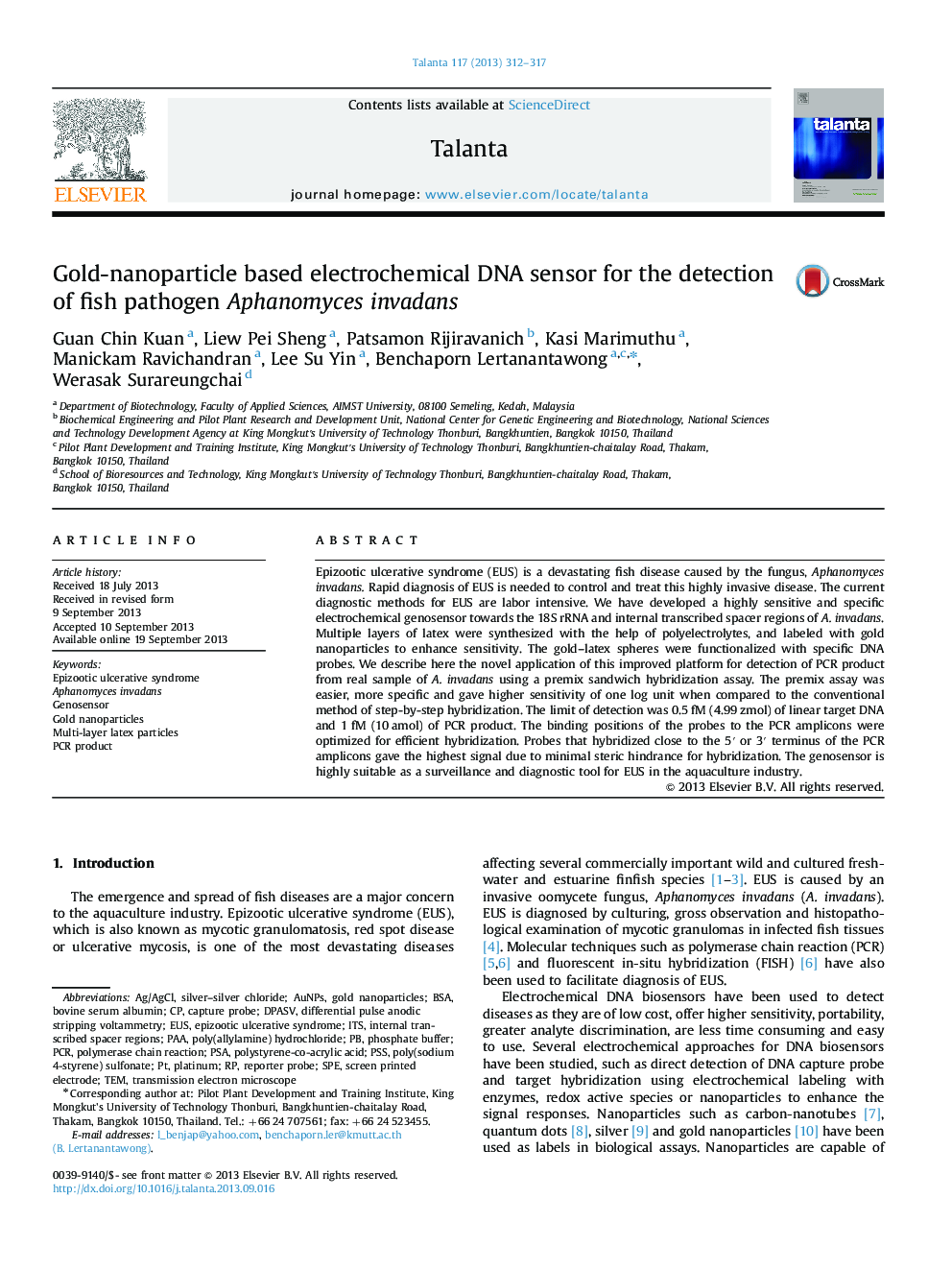| کد مقاله | کد نشریه | سال انتشار | مقاله انگلیسی | نسخه تمام متن |
|---|---|---|---|---|
| 7681971 | 1495818 | 2013 | 6 صفحه PDF | دانلود رایگان |
عنوان انگلیسی مقاله ISI
Gold-nanoparticle based electrochemical DNA sensor for the detection of fish pathogen Aphanomyces invadans
دانلود مقاله + سفارش ترجمه
دانلود مقاله ISI انگلیسی
رایگان برای ایرانیان
کلمات کلیدی
PCR productAphanomyces invadansITSDPASVEUSPSSSPEPAAPSAAg/AgCl - Ag / AgClAuNPs - AuNP هاBSA - BSAbovine serum albumin - آلبومین سرم گاوScreen printed electrode - الکترود چاپ شده روی صفحهTem - این استphosphate buffer - بافر فسفاتEpizootic ulcerative syndrome - سندرم زخم اپیزیولوژیکInternal transcribed spacer regions - مناطق داخلی رونویسی شدهTransmission electron microscope - میکروسکوپ الکترونی انتقالGold nanoparticles - نانوذرات طلاpolymerase chain reaction - واکنش زنجیره ای پلیمرازPCR - واکنش زنجیرهٔ پلیمرازDifferential pulse anodic stripping voltammetry - ولتاژ سنکرون ساییدگی آنالوگ پالس دیفرانسیلPlatinum - پلاتینGenosensor - ژنوسنسور
موضوعات مرتبط
مهندسی و علوم پایه
شیمی
شیمی آنالیزی یا شیمی تجزیه
پیش نمایش صفحه اول مقاله

چکیده انگلیسی
Epizootic ulcerative syndrome (EUS) is a devastating fish disease caused by the fungus, Aphanomyces invadans. Rapid diagnosis of EUS is needed to control and treat this highly invasive disease. The current diagnostic methods for EUS are labor intensive. We have developed a highly sensitive and specific electrochemical genosensor towards the 18S rRNA and internal transcribed spacer regions of A. invadans. Multiple layers of latex were synthesized with the help of polyelectrolytes, and labeled with gold nanoparticles to enhance sensitivity. The gold-latex spheres were functionalized with specific DNA probes. We describe here the novel application of this improved platform for detection of PCR product from real sample of A. invadans using a premix sandwich hybridization assay. The premix assay was easier, more specific and gave higher sensitivity of one log unit when compared to the conventional method of step-by-step hybridization. The limit of detection was 0.5Â fM (4.99Â zmol) of linear target DNA and 1Â fM (10Â amol) of PCR product. The binding positions of the probes to the PCR amplicons were optimized for efficient hybridization. Probes that hybridized close to the 5â² or 3â² terminus of the PCR amplicons gave the highest signal due to minimal steric hindrance for hybridization. The genosensor is highly suitable as a surveillance and diagnostic tool for EUS in the aquaculture industry.
ناشر
Database: Elsevier - ScienceDirect (ساینس دایرکت)
Journal: Talanta - Volume 117, 15 December 2013, Pages 312-317
Journal: Talanta - Volume 117, 15 December 2013, Pages 312-317
نویسندگان
Guan Chin Kuan, Liew Pei Sheng, Patsamon Rijiravanich, Kasi Marimuthu, Manickam Ravichandran, Lee Su Yin, Benchaporn Lertanantawong, Werasak Surareungchai,